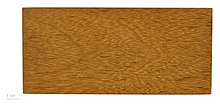Goupia glabra
| Goupia glabra | ||||||||||||
|---|---|---|---|---|---|---|---|---|---|---|---|---|
| Systematics | ||||||||||||
|
||||||||||||
| Scientific name | ||||||||||||
| Goupia glabra | ||||||||||||
| Aubl. |
Goupia glabra is a tree in the Goupiaceae family from central to northern South and Central America .
description
Goupia glabra grows as a semi-evergreen tree up to 35–40 meters high. The trunk diameter reaches up to 70-90 centimeters. High buttress roots are often formed. The slightly rough, somewhat cracked bark is brown-gray and, with age, a little scaly to flaky.
The simple, thin-leather leaves are alternate and have short stalks. The slightly runny leaf stalk is up to 0.5–1 centimeters long. The ovate to elliptical, pointed to pointed leaves, often with an uneven blade, are 5–12 centimeters long and completely to finely notched and sawed on the edge. They are bald on top and weakly hairy on the underside of the veins. The veins are pinnate with curved side veins. The larger, elongated stipules are sloping.
Axillary, multi-flowered and stalked umbels are formed. The long-stemmed flowers are hermaphroditic with a double flower envelope . The slender, 8-15 millimeter long flower stalks are slightly fine-haired. The cup-shaped calyx is small with short tips. The ragged, 7–8 millimeter long, narrow-eilanzettlichen and slightly fine-haired petals with a tapering tip and slightly folded edges are mustard-yellow-white with a red base. The 5 short, free stamens have hairy anthers at the top. The multi-chambered, flattened, rounded ovary is on top, with several, short and awl, protruding styluses with minimal, heady scars . There is a discus .
Small, bald and multi-seeded, initially yellow, then red and blackish when ripe, 4–6 millimeters in size, round, chambered stone fruits with a permanent calyx and firm skin are formed. The yellow-brown, 2–5 seeds (Pyrene) are up to 1.5 millimeters in size.
use
The very severe, moderate resistant, hard wood with a strong odor known as Goupi , Kabukalli , copy , Cupiuba or Stinkwood . It is used for various applications.
The bark and bark juice are used medicinally.
literature
- K. Kubitzki : The Families and Genera of Vascular Plants. Vol. XI: Flowering Plants Eudicots , Springer, 2014, ISBN 978-3-642-39416-4 , pp. 219 ff.
- AM Polak, HR Rypkema: Major Timer Trees of Guyana A Field Guide. Tropenbos, 1992, ISBN 90-5113-013-9 , online (PDF; 8.5 MB).
- Franklin R. Longwood: Present and Potential Commercial Timbers of the Caribbean. Agriculture Handbook 207, USDA, 1962, p. 69 f, limited preview in the Google book search.
- J. Gérard, D. Guibal, S. Paradis, J.-C. Cerre: Tropical Timber Atlas. Éditions Quæ, 2017, ISBN 978-2-7592-2798-3 , p. 261 ff, limited preview in the Google book search.
Web links
- Goupia glabra at Useful Tropical Plants.
- Goupia glabra on lachaussetterouge.fr (pictures).

